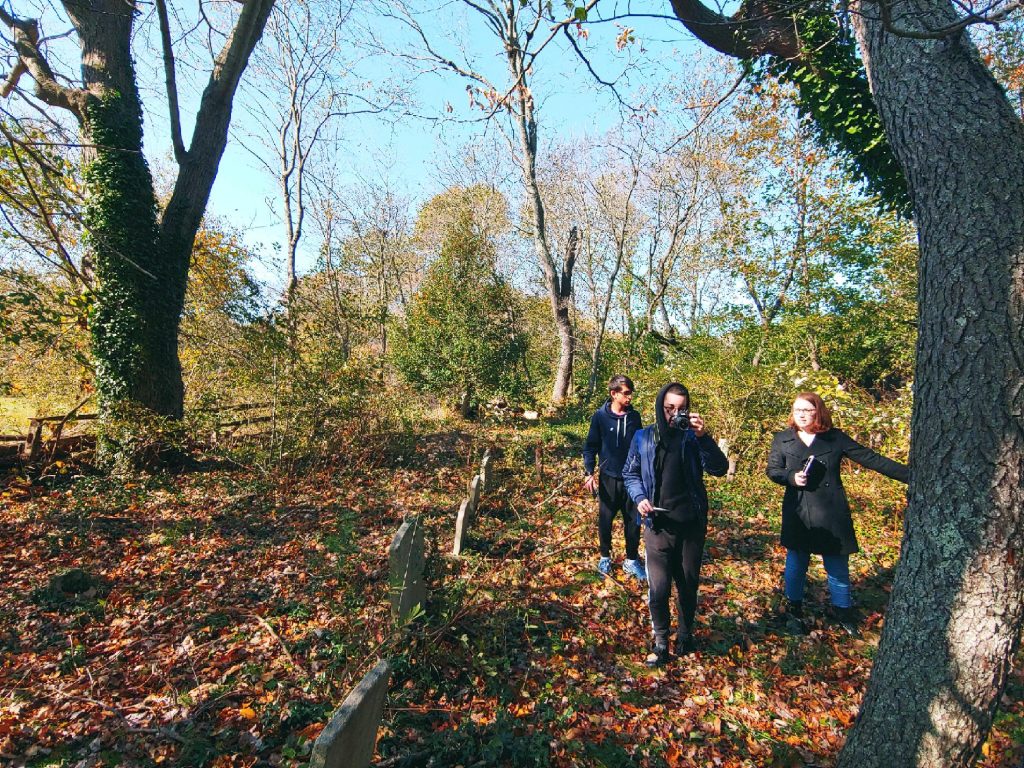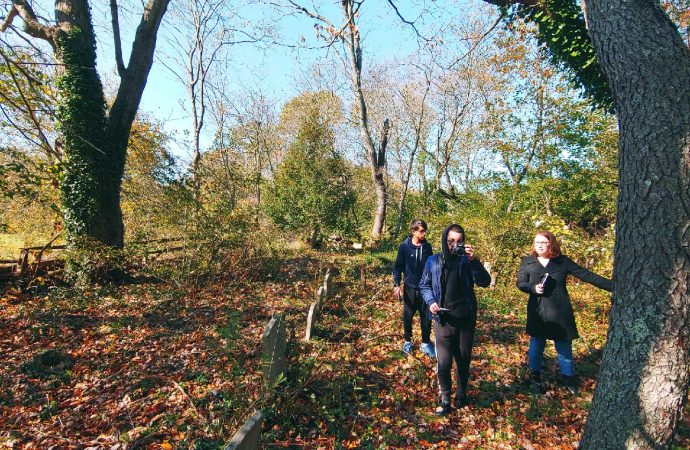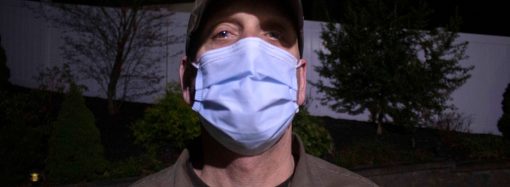By Brianne Ledda
Fall 2019 JRN 364

Jon Kuperschmid, a 15-year-old sophomore at East Hampton High School, was stunned last February when he discovered in an eighteenth century Long Island estate inventory that cheese was worth more than an enslaved woman.
Her name was Phillis, and she was valued at eight units while “sundry cheeses” were valued at 15. Kuperschmid is unsure of the currency but assumes it’s either English pounds or gold. The 1774-1789 account book from slave holder David Gardiner listed 16 enslaved people, including Phillis, valued between five and 70 units. Kuperschmid was shocked that “a human life was worth less than a piece of dairy.”
He was volunteering for the Plain Sight Project — a research effort that’s uncovering the history of slavery in East Hampton — when he made the discovery in the estate inventory kept by Gardiner, an early Long Island plantation owner who owned what is now Gardiners Island in East Hampton. Kuperschmid said that before he started volunteering with the project, he had no idea slavery existed on the island.
“When you think of slavery, you think of the South,” he said, adding that the narrative taught in his school suggested to students that the institution passed over Long Island.
The Plain Sight Project intends to change this narrative — if not for all of Long Island, then at least in East Hampton, where Kuperschmid attends school. The project’s goal is to document names “of all the enslaved people that have ever lived in East Hampton town,” according to David Rattray, editor-in-chief at the East Hampton Star and founder of the Plain Sight Project.
He hopes that the information will be used to inform the public about slavery. The project aims to eventually create an online database, and Kuperschmid said he hopes to help integrate Long Island slavery — which existed from the 1600s until 1827, when slave ownership became illegal for full-time state residents— into school curriculums.
“The idea is to be able to create a story for each of the enslaved people we find,” Kuperschmid said of the volunteer work he has been doing since February 2019. “So eventually [we’ll] have an online database where people can look up certain people, maybe, or certain family, and learn about the people who helped build their town.”
In the Media:
A version of this story aired on WSHU, the Long Island National Public Radio affiliate station.
It also appeared in Newsday, Long Island’s only daily newspaper.
The project kicked off in 2017, after Rattray stumbled across church records while doing research for a newsarticle. He was investigating an enslaved person named Ned, whose gravestone vanished for a number of years before it was eventually found and returned in 2015.
The records list births and deaths in East Hampton during the “height of slavery,” he said. He asked an intern to type it up, and the project grew from there.
Now, three volunteers are searching the East Hampton Library’s Long Island Collection for records that can fill in the pieces of a forgotten history.
Containing one of the largest collections of manuscript materialsin Nassau and Suffolk Counties,the five-room wing holds more than 100,000 documents — including about 70 original whaling books and hundreds of account books — dating back centuries. Andrea Meyer, the head of the Long Island Collection, said that the earliest items she’s personally seen in the collection date to 1599.
Kuperschmid works with documents using his bare hands, turning pages from the bottom corner — doing his best to handle them with care. Before jumping in, Rattray describes to Kuperschmid what he’s looking for, and then Kuperschmid talks to Meyer. He said that she normally has books waiting for him when he arrives.
Meyer said that volunteers for the Plain Sight Project typically set up a “recurring day or a period of a couple weeks where they’ll be in.” She makes sure there’s a seat for them, and a plug for their computer cords. When other groups or researchers make appointments, they share space at the wing’s two tables. The team “has been very gracious about letting visitors from far away get seats” on busy days, Meyer said.
Volunteers might “find nothing” some days, but 10 names another day, according to Meyer. Kuperschmid said he typically researches for an hour and half after school twice a week. Because of the meticulous nature of the work, he usually gets through between two and five documents in one sitting.
Volunteers for the project have expanded from East Hampton High School students working in their free time to include a mother and a retiree. Kuperschmid is the only student at the moment, but Rattray expects two more volunteers come summer break.
The Plain Sight Project already found that more than 250 enslaved people lived in East Hampton. Two known graves in town mark two people of African descent from the Revolutionary period and earlier. Those graves led Rattray to assume before he started the project that they were the only enslaved people in East Hampton. He said most people assumed the town had none.
“We want people to know that slavery was as much a part of the North as any other part of the country,” Rattray said. He said that the story Long Islanders tell about their origins — such as from the American Revolution — “omits the muscle and intelligence and the skills that enslaved people lent to the American project.”
“We want people to know that slavery was as much a part of the North as any other part of the country,” Rattray said. He said that the story Long Islanders tell about their origins — such as from the American Revolution — “omits the muscle and intelligence and the skills that enslaved people lent to the American project.”
David Rattray, founder of the Plain Sight Project and editor-in-chief of the East Hampton Star
Documents detailing slavery on Long Island are hard to find. Historian Jennifer Anderson has had to cobble together stories from scraps.
“Oftentimes, it might be sources, for example, that an enslaved person didn’t put together but where they just happened to show up in the archives and pages of their owner or sometimes in legal records,” said Anderson, a history professor at Stony Brook University and expert on colonialism and slavery on Long Island.
Sylvester Manor, Long Island’s first slave plantation, is packed with artifacts and stores more than 10,000 documents at New York University’s Fales Library. Located on Shelter Island, which is tucked between Long Island’s north and south forks, Sylvester Manor was transformed into an educational farm in 2009. Very few of its records describe the lives of enslaved people on the manor.
“Although this house is filled with thousands of documents, those kind of records were not kept,” said Donnamarie Barnes, an archivist at Sylvester Manor and member of the Plain Sight Project. “We have to imagine, and you have to do the imagining.”
She explained that creating actual histories is “hard to do because we don’t have the documentation.”
The Plain Sight Project resorts to combing through inventories and account books for most of its information. They range from “literally being pieces of paper in tatters that were once bound together to leather bound volumes still in good shape,” she said. Those that predate 1850 usually need at least some added support or wrapping.
East Hampton librarian and archivist Steve Boerner, who transcribes the account books into a digital database, said that they’re among the best records available.
“They really give you so much information beyond what people were able to purchase and sell and consume,” he said — such as, in many cases, the names of people who were most likely enslaved.
One document Boerner digitized recorded an enslaved person who was traded for 12 cents — but he or she was “probably a gift,” he said.
This chronic lack of documentation feeds misconceptions.
These detailed receipts, inventories and fiscal accounts provide little narrative information about the lives of enslaved people. Firsthand written accounts of slavery in the northern colonies are rare. One of the best known is the account of Venture Smith — a formerly enslaved man who wrote an autobiography called “A Narrative of the Life and Adventures of Venture, a Native of Africa: But Resident above Sixty Years in the United States of America, Related by Himself.”
An exhibition at the Long Island Museum called the “Long Road to Freedom” that ran from February through May examined the legacy of slavery on Long Island, focusing on the African American experience there from the colonial period through the nineteenth century. Feedback on the exhibit, collected by its curator Jonathan Olly, demonstrated that many people were unaware that the institution existed on the island.
The exhibition, which featured hundreds of objects, included one section that focused on the “slavery story” while another focused on the “freedom story,” which told stories “about the development of African American communities throughout the 19th century,” Olly said. Towards the end, there was a section that looked towards the African American experience in the 20th century.
“It is so easy to pass the buk [sic] to the south for their atrocities,” one response read. “The problem is built into the fabric of our nation, and this exhibit allows us to face our history. Bone chilling. Well done.”
“Thank you for this exhibit. I did not know,” another read.
Slavery is a topic that’s often glossed over in American schools. On Long Island, slavery’s local history is rarely taught at all. Teaching Tolerance, an organization that offers free resources to K-12 educators to help students “explore identity and diversity, recognize injustice and learn to take action,” contracted with Survey USA in early December 2016 to conduct an online poll of 1,000 high school seniors across the U.S.
It saw dismal results. Only 8% of students identified slavery as the cause of the Civil War, only 32% were able to identify which amendment formally ended slavery and 29% mistakenly believed that Frederick Douglass, Henry “Box” Brown and Harriet Tubman led slave rebellions.
“It has not been part of most people’s educational curriculum. It’s not part of the telling of the founding of a town really,” Sylvester Manor archivist Barnes said. “It has sort of been that history that was forgotten to be remembered, or they remembered to forget it.”
Lynda Day, a professor in Africana Studies at Brooklyn College, said that history has been “erased.”
“If you pick up a fourth grade local history book, there won’t be anything about black history in there,” she said. “There won’t be much about Native American history either.”
Day noted that textbooks might tell stories about Native Americans helping European settlers, but they won’t mention that local farmers in Massapequa massacred a Native American village.
“People don’t want to talk about the horrible things that happened right here,” she said. “We can talk about the Holocaust. And you know why I think we can talk about the Holocaust, is because it happened in Germany. The Nazis did that.”
“People don’t want to talk about the horrible things that happened right here,” she said. “We can talk about the Holocaust. And you know why I think we can talk about the Holocaust, is because it happened in Germany. The Nazis did that.”
Lynda Day, professor of Africana Studies, Brooklyn College
A 58-page sample lesson from the New York-based Integrated Social Studies/ELA Curriculum, which includes more than 235 school districts, that was updated in April examines slavery in New York State. It includes videos and outside resources on how to teach about human rights abuses and racism, and defines the term “enslaved person” — which is now used by most historians, since it humanizes and grants more agency to enslaved people — rather than “slave.”
Georgette Grier-Key, a member of the Plain Sight Project and the executive director and chief curator of the Eastville Historical Society, pointed out, however, that just because a lesson plan exists doesn’t mean it’s used in the classroom. A lot of teachers still feel uncomfortable teaching slavery, she said, and therefore avoid teaching it at all.
In recent years, however, more Long Island historians have been focusing on educating people about slavery’s legacy.
The historical society in Southold, a town on the north fork, opened a new exhibit in August on the lives of enslaved people in town. Southampton plans to build a museum on a site previously home to Pyrrhus Concer, a formerly enslaved man from Southampton who was on the first American ship to visit Tokyo. Grier-Key is trying to convince the Southampton school district to incorporate him into the curriculum.
On a national level, the New York Times is marking the 400th anniversary of slavery’s beginning in the United States with its 1619 project, which aims to “reframe the country’s history” and place “the consequences of slavery and the contributions of black Americans at the very center of the story we tell ourselves about who we are.”
PBS offers lesson plans and resources for educators tackling slavery with grades 3-12, and popular movies like “12 Years a Slave” and “Harriet” are attempting to share a more honest portrayal of American slavery.
“I think the time is right, right now,” Grier-Key said. She said that media attention makes talking about this part of the American story more “palatable.”
But in the past, discussion was more difficult. Grier-Key pointed to a 2013 exhibit she helped curate, “Hidden and Forbidden,” as an example.
The exhibit, mounted by the Suffolk County Historical Society (SCHS) to commemorate Black History Month, tracked the history of racism on Long Island from slavery to the present day, including Jim Crow and, more recently, the Ku Klux Klan (KKK), which is still active on Long Island. SCHS called the exhibit its “most controversial exhibition to date.”
Grier-Key said that people were surprised by its contents, and some felt that materials such as KKK regalia and other racist memorabilia shouldn’t be on display. One comment argued that “Black history is supposed to be a celebration of Black achievements.”
SCHS director at the time, Kathryn Curran, wrote in a 2014 journal that “upon viewing the exhibition, a well-known local newscaster stood frozen in the gallery, overwhelmed by the impact of the things and objects shown. Stunned, he said, ‘Kathy, how am I going to put a positive spin on this?’”
Grier-Key pointed out that public discussions about slavery need to be structured and facilitated, because “the wrong conversation can really do a disservice.”
“It’s really not about who did wrong or who did right,” she said. “The problem is, this is the stain on America. We don’t want to talk about it. It did happen.”
Rattray of the Plain Sight Project said that records indicate all but one of the families in East Hampton in the 1650s had one or two enslaved people in their household or farmstead, including his own. That was the core moment, he said, when he realized that just asking questions, even if they lack answers, will help people think “a little differently” about slavery.
In the meantime, Kuperschmid is meeting with the teacher he had in seventh grade U.S. history to talk about integrating a narrative about local slavery into the curriculum.
Educating people will help them “really know the true history of our town, and just give credit where it’s due,” Kuperschmid said. “These are the people who really built our town that we live in.”
Editor’s Note:
This printed edition of “Telling their stories” includes an article about St. David AME Zion Church that is a corrected, updated version of the original that appeared in Newsday on August 16, 2020.

